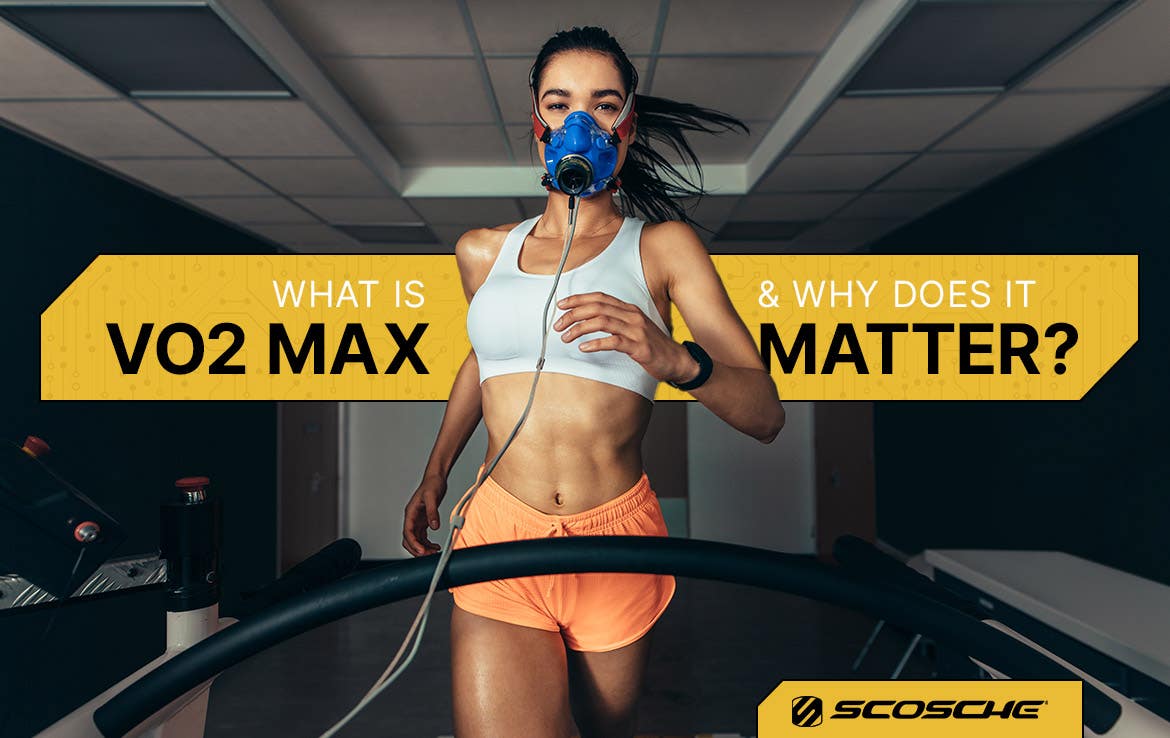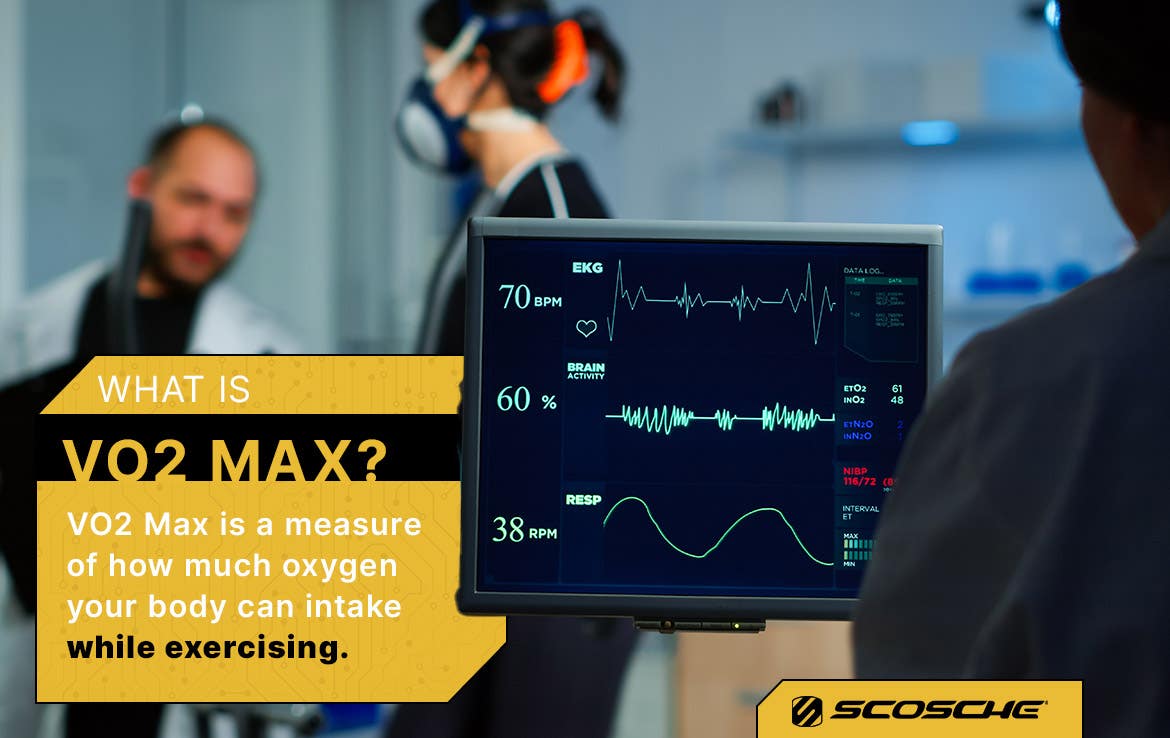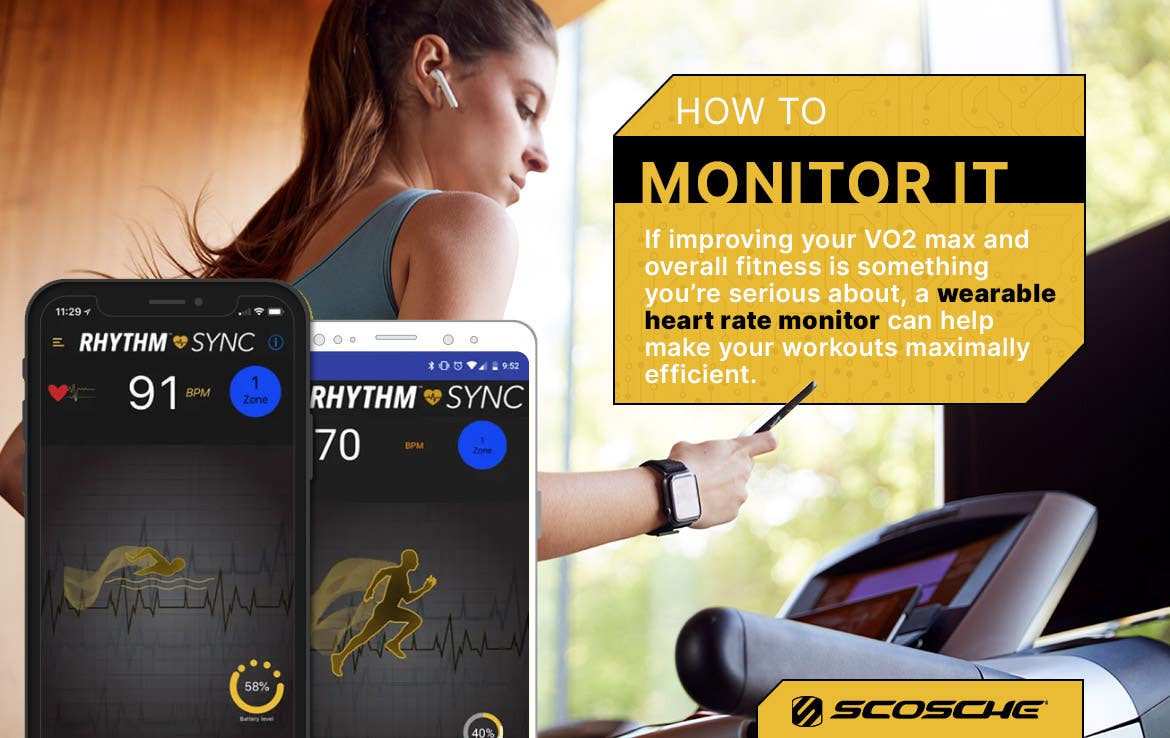What Is VO2 Max and Why Does It Matter?

If you didn’t compete in sports growing up, there’s a decent chance you’ve never heard the term VO2 max used. If you have, you might not have an understanding of what a VO2 max is or why you should be interested in improving yours.
You don’t need to be a pro athlete to want to know what your VO2 is and strive to improve it. This measure of fitness is an important part of your daily life, but you might not even know it!
What Is VO2 Max?
In short, your VO2 max is a measure of how much oxygen your body can intake while exercising. It measures how much oxygen-rich blood your heart can pump and how efficiently it can do so. In layman’s terms, it’s a baseline measure of your overall fitness. The higher your VO2 max, the more efficient and robust your aerobic fitness level is.


In the term VO2 max, the (V) stands for “rate” (e.g., the rate of oxygen your body is able to utilize during intense training sessions), the (O) stands for “oxygen” and max is simply short for maximum.
Why Does It Matter?
Whether you know it or not, your VO2 max determines a lot about your life. Your VO2 max is an indicator of the state of your overall health and impacts everything — from how well you can run a mile at max effort to how easy it is for you to walk up long flights of stairs.
Your VO2 max isn’t the only health indicator you should worry about, of course. Things like weight, diet and overall mood can all be good indicators of just how healthy you are, but a VO2 max provides an objective baseline to work from.
What Is a Good VO2 Max?
There’s no singular answer to this. It’s similar to asking what a good marathon time is. While you could throw out a number, it would be unrealistic for some people and not nearly a challenge for others.
Your VO2 max should be based on your age and gender. Beyond just those two factors, you also want to account for your overall fitness level and general activity state. If you aren’t someone who works out often or you tend to lead a sedentary lifestyle, you want to have an attainable goal in mind for your VO2 max and build from there. If you’re someone who routinely trains, “good” is going to be a different score for you.
Why Would You Want to Improve It?
Well, for one, it’s not enjoyable to be winded after walking up a flight of stairs. The importance of VO2 max training goes beyond that, though. If your VO2 max is lower than it should be, you’re at an increased risk for a slew of health problems and are less likely to live well into old age.
A poor VO2 max is an indicator that you could be at increased risk for a number of ailments:


- Increased stroke risk
- Increased risk of heart disease
- Increased risk of diabetes
- Increased risk of cancer
- Lower quality of sleep
- Lower overall quality of life
- Lowered ability to regulate mood
While not an exhaustive list of the risks of a poor VO2 max, those are some of the biggest and most common problems associated with it.
How Is It Measured?
Technically, the only true way to get your VO2 max tested is by going into a lab that offers the tests and having a professional do it. While you can absolutely do it yourself, the professional testing is, as you might have guessed, the most accurate.
If you don’t want to go into a lab and get hooked up to a machine and tubes (that’s basically what happens), you have a couple of other options.
Trainers with a Certification
You can find a personal trainer or other fitness instructor with a certification to perform VO2 max testing. While they won’t hook you up to the state of the art machinery you’d find in a lab, they’ll offer something pretty viable that’s better than you doing it yourself.
Trainers perform what’s called “submaximal testing.” While submaximal testing won’t give you your true VO2 max, it’s pretty close and a perfectly fine approximation for most ordinary people. You’ll perform some sort of running test or combination of running and walking, depending on your fitness level. Which exact test you get depends on whom you go to and your level of fitness, though they’ll all give you a good idea of your VO2 max.
Self-Administered Test
While not as accurate as a lab or personal trainer, this one is free. Like the previous option, there are a handful of tests you can perform depending on your fitness level and the equipment you have. Some high-end smartwatches offer a VO2 max function. If you’ve got one of those, hey, you’re good to go. If not, you can look up a VO2 max test and determine which one makes sense for you.
All self-administered VO2 max tests will consist of a warmup followed by running or walking a mile at submaximal effort and then checking your heart rate. While you can do the manual method to check your heart rate, having a heart rate monitor will offer maximum accuracy.
What to Know
Like any other test of fitness, you want to make sure you wear comfortable athletic clothing and get in a proper warmup before attempting this. If you have a lower level of fitness, opt for a walking-based VO2 max test, at least to start. If improving your VO2 max and overall fitness is something you’re serious about, a wearable heart rate monitor can help make your workouts maximally efficient.


How to Monitor It
You can definitely overdo VO2 max testing and training. A good rule of thumb is to do no more than three workouts a week that focus on improving your VO2 max. You want to work on improving your VO2 max, of course, but you can also overwork yourself when you focus too much of your weekly workout time on VO2 max. Make sure that you stay balanced in your overall approach when you're training. When not doing intense interval training, you can still work on your VO2 max in less extreme ways, such as low intensity steady state (LISS) cardio.
When it comes to VO2 max testing, you want to test your VO2 max anywhere from one to four times a year, depending on your fitness goals. If you’ve got a really aggressive fitness regimen and you’re deliberately trying to increase your VO2 max, you can test every three months or so. For most people just looking to get into better shape and use VO2 max as a touchpoint along that journey, every six to 12 months is plenty.
Shop Heart Rate Monitors to Track Your Fitness Progress
How to Improve Your VO2 Max
Start Training
Look, this may seem trite, but it’s true. Under 20 percent of the American population engages in some sort of daily physical activity. You don’t have to run yourself into the ground, but you do want to be active in some way daily, even if you just walk around your neighborhood.
If you aren’t currently training, the best way to improve your VO2 max is — no surprise — to start training. Establish a manageable, repeatable fitness routine that works for you, and within a couple of months (if you stick to it), you should see some increase in your VO2 max (plus you’ll just feel better). Just by running, swimming, lifting weights or participating in whatever fitness activity you enjoy, you’ll improve your VO2 max and overall health.
If you’re overweight, losing a few pounds will go far in your efforts to build your VO2 max. However, if you’re already in good shape, you may not want to actively lose more weight to up your VO2 max. While you might think that the greatest marathoners, who are all stick thin, have great VO2 maxes, you’d actually be mistaken. If you want to get into the nerdy data of it all, there’s often an inverse relationship between running efficiency and VO2 max. In fact, many marathoners, who are incredibly efficient runners, don’t have the most stellar VO2 max levels.
VO2 Max-Specific Training
Let’s say you’re already engaged in some sort of physical activity. Great! You’ll need to work a bit harder to see VO2 max increases though. Starting off, make sure you’re engaging in high-intensity exercise. You want to be training at 90 percent or so of your maximum heart rate to be in that high-intensity zone. If you don’t know your maximum heart rate, a good rule of thumb is to subtract your age from 220. For example, a 40-year-old would have a maximum heart rate of 180.
Internal training and continuous training are both great ways to increase your VO2 max as well. You want to limit your rest time and up your training intensity to target VO2 max increases.
In the same way that athletes cross train, you may want to consider that as well. If you’re already a consistent runner, maybe switch things up. Try swimming or biking. Participating in different aerobic exercises is going to push your body in new ways and give it stimuli it’s not used to. This can help improve your VO2 max, especially if you’ve been stuck at a plateau for a while.
Find a Group
This is especially helpful if you’re new to fitness. Whether you’re a runner, swimmer, cyclist or anything else, having a group to train with can be really helpful. Even if you’re just looking to go to a gym, going with a friend not only helps you stay accountable, but it also makes it a bit more fun. If none of your friends are interested in this type of training, there are often local interest groups that you can connect with on social media. If you have a group to guide and motivate you, it will make your journey to improving your VO2 max more fruitful and enjoyable.
Use Technology
Wearable tech has come a long way and is really helpful for those looking to improve their VO2 max and overall fitness. If you want to push yourself to 90 percent or so of your max heart rate, you want a reliable way to track that effort and know when you’re hitting the appropriate thresholds.


A health armband, for example, can give you data on your heart rate and level of exertion that you can use to modify your exercise as necessary to make sure you’re hitting your target heart rate. You aren’t limited to just running or biking if you want to monitor your heart rate, though. Someone looking to improve their VO2 max through swimming, for example, may want to look into a waterproof heart rate monitor. You can get your laps in while still gathering valuable data about your VO2 max.
Find a Wearable Heart Rate Monitor to Boost Your Fitness Journey
A VO2 max test is helpful, and it’s a good baseline and reference point for your overall fitness. A high VO2 max is a good indicator that you’re at an increased likelihood of living a longer, higher-quality life. That being said, it’s only one measure of fitness. While good to improve upon, you don’t want to be singularly focused on improving your VO2 max only. Your VO2 max numbers can vary from one day to the next and be affected by your sleep, nutrition and even the altitude where your test takes place.
As long as you’re consistently active and looking to push yourself to be fit and healthy, your VO2 max numbers will come along on their own, and you can feel good about yourself and your accomplishments.
Image Credits
Jacob Lund/Shutterstock.com
Monkey Business Images/Shutterstock.com
DC Studio/Shutterstock.com
ArtHead/Shutterstock.com